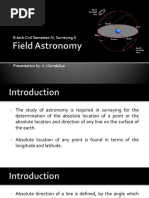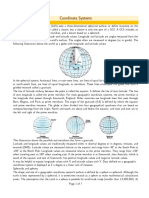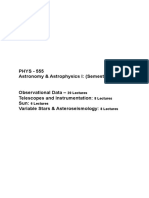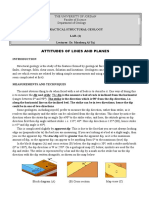Azimuth - Wikipedia, The Free Encyclopedia PDF
Azimuth - Wikipedia, The Free Encyclopedia PDF
Uploaded by
Thuy Thanh LeCopyright:
Available Formats
Azimuth - Wikipedia, The Free Encyclopedia PDF
Azimuth - Wikipedia, The Free Encyclopedia PDF
Uploaded by
Thuy Thanh LeOriginal Description:
Original Title
Copyright
Available Formats
Share this document
Did you find this document useful?
Is this content inappropriate?
Copyright:
Available Formats
Azimuth - Wikipedia, The Free Encyclopedia PDF
Azimuth - Wikipedia, The Free Encyclopedia PDF
Uploaded by
Thuy Thanh LeCopyright:
Available Formats
Azimuth - Wikipedia, the free encyclopedia
10/13/13 3:56 PM
Azimuth
From Wikipedia, the free encyclopedia
An azimuth ( i /zm/; from Arabic !"#$ as-samt, meaning "a way, a part, or quarter"[1]) is an angular measurement in a spherical coordinate system. The vector from an observer (origin) to a point of interest is projected perpendicularly onto a reference plane; the angle between the projected vector and a reference vector on the reference plane is called the azimuth. An example is the position of a star in the sky. The star is the point of interest, the reference plane is the horizon or the surface of the sea, and the reference vector points north. The azimuth is the angle between the north vector and the perpendicular projection of the star down onto the horizon.[2] Azimuth is usually measured in degrees (). The concept is used in navigation, astronomy, engineering, mapping, mining and artillery.
The azimuth is the angle formed between a reference direction (North) and a line from the observer to a point of interest projected on the same plane as the reference direction.
Contents
1 Navigation 1.1 True north-based azimuths 2 Calculating azimuth 3 Mapping 4 Astronomy 5 Other systems 5.1 Right ascension 5.2 Horizontal coordinate 5.3 Polar coordinate 6 Other uses of the term 7 See also 8 Notes 9 References 10 External links
Navigation
http://en.wikipedia.org/wiki/Azimuth Page 1 of 5
Azimuth - Wikipedia, the free encyclopedia
10/13/13 3:56 PM
In land navigation, azimuth is usually denoted alpha, , and defined as a horizontal angle measured clockwise from a north base line or meridian.[3][4] Azimuth has also been more generally defined as a horizontal angle measured clockwise from any fixed reference plane or easily established base direction line.[5][6][7] Today the reference plane for an azimuth is typically true north, measured as a 0 azimuth, though other angular units (grad, mil) can be used. Moving clockwise on a 360 degree circle, east has azimuth 90, south 180, and west 270. There are exceptions: some navigation systems use south as the reference plane. Any direction can be the plane of reference, as long as it is clearly defined. Quite commonly, azimuths or compass bearings are stated in a system in which either north or south can be the zero, and the angle may be measured clockwise or anticlockwise from the zero. For example, a bearing might be described as "(from) south, (turn) thirty degrees (toward the) east" (the words in brackets are usually omitted), abbreviated "S30E", which is the bearing 30 degrees in the eastward direction from south, i.e. the bearing 150 degrees clockwise from north. The reference direction, stated first, is always north or south, and the turning direction, stated last, is east or west. The directions are chosen so that the angle, stated between them, is positive, between zero and 90 degrees. If the bearing happens to be exactly in the direction of one of the cardinal points, a different notation, e.g. "due east", is used instead.
True north-based azimuths
From North North North-Northeast Northeast East-Northeast East East-Southeast Southeast South-Southeast 0 or 360 South 22.5 45 67.5 90 112.5 135 157.5 Southwest West Northwest 180 225 270 315 South-Southwest 202.5 West-Southwest 247.5 West-Northwest 292.5 North-Northwest 337.5
Calculating azimuth
We are standing at latitude , longitude zero; we want to find the azimuth from our viewpoint to Point 2 at latitude , longitude L (positive eastward). We can get a fair approximation by assuming the Earth is a sphere, in which case the azimuth is given by
A better approximation assumes the Earth is a slightly-squashed sphere (a spheroid); "azimuth" then has at least two very slightly different meanings. "Normal-section azimuth" is the angle measured at our viewpoint by a theodolite whose axis is perpendicular to the surface of the spheroid; "geodetic azimuth" is the angle between north and the geodesic that is, the shortest path on the surface of the spheroid from our viewpoint
http://en.wikipedia.org/wiki/Azimuth Page 2 of 5
Azimuth - Wikipedia, the free encyclopedia
10/13/13 3:56 PM
to Point 2. The difference is usually unmeasurably small; if Point 2 is not more than 100 km away the difference will not exceed 0.03 arc second. Various websites will calculate geodetic azimuth e.g. GeoScience Australia site (http://www.ga.gov.au/geodesy/datums/vincenty_inverse.jsp). Formulas for calculating geodetic azimuth are linked in the distance article. Normal-section azimuth is simpler to calculate; Bomford says Cunningham's formula is exact for any distance. If is the flattening for the chosen spheroid (e.g. 1/298.257223563 for WGS84) then
If
= 0 then
To calculate the azimuth of the sun or a star given its declination and hour angle at our location, we modify the formula for a spherical earth. Replace with declination and longitude difference with hour angle, and change the sign (since hour angle is positive westward instead of east).
Mapping
There are a wide variety of azimuthal map projections. They all have the property that directions (the azimuths) from a central point are preserved. Some navigation systems use south as the reference plane. However, any direction can serve as the plane of reference, as long as it is clearly defined for everyone using that system.
Astronomy
Used in celestial navigation, an azimuth is the direction of a celestial body from the observer.[8] In astronomy, an azimuth is sometimes referred to as a bearing. In modern astronomy azimuth is nearly always measured from the north. (The article on coordinate systems, for example, uses a convention measuring from the south.) In former times, it was common to refer to azimuth from the south, as it was then zero at the
http://en.wikipedia.org/wiki/Azimuth Page 3 of 5
Azimuth - Wikipedia, the free encyclopedia
10/13/13 3:56 PM
same time that the hour angle of a star was zero. This assumes, however, that the star (upper) culminates in the south, which is only true if the star's declination is less than (i.e. further south than) the observer's latitude.
Other systems
Right ascension
If instead of measuring from and along the horizon the angles are measured from and along the celestial equator, the angles are called right ascension if referenced to the Vernal Equinox, or hour angle if referenced to the celestial meridian.
A standard Brunton Geo compass, used commonly by geologists and surveyors to measure azimuth
Horizontal coordinate
In the horizontal coordinate system, used in celestial navigation and satellite dish installation, azimuth is one of the two coordinates. The other is altitude, sometimes called elevation above the horizon. See also: Sat finder.
Polar coordinate
In mathematics the azimuth angle of a point in cylindrical coordinates or spherical coordinates is the anticlockwise angle between the positive x-axis and the projection of the vector onto the xy-plane. The angle is the same as an angle in polar coordinates of the component of the vector in the xy-plane and is normally measured in radians rather than degrees. As well as measuring the angle differently, in mathematical applications theta, , is very often used to represent the azimuth rather than the symbol phi .
Other uses of the term
For magnetic tape drives, azimuth refers to the angle between the tape head(s) and tape. In sound localization experiments and literature, the azimuth refers to the angle the sound source makes compared to the imaginary straight line that is drawn from within the head through the area between the eyes. An azimuth thruster in shipbuilding is a propeller that can be rotated horizontally.
See also
Altitude (astronomy) Azimuthal quantum number Bearing (navigation) Course (navigation) Inclination Longitude Magnetic declination
http://en.wikipedia.org/wiki/Azimuth Page 4 of 5
Azimuth - Wikipedia, the free encyclopedia
10/13/13 3:56 PM
Panning (camera) Solar azimuth angle Sound Localization Zenith
Notes
1. ^ Charles Knight. Arts and sciences: or, Fourth division of "The English encyclopedia", Volume 1. Bradbury, Evans & Co. p. 772. 2. ^ http://dictionary.reference.com/browse/azimuth 3. ^ U.S. Army, Map Reading and Land Navigation, FM 2126, Headquarters, Dept. of the Army, Washington, D.C. (7 May 1993), ch. 6, p. 2 4. ^ U.S. Army, Map Reading and Land Navigation, FM 2126, Headquarters, Dept. of the Army, Washington, D.C. (28 March 1956), ch. 3, p. 63 5. ^ U.S. Army, ch. 6 p. 2 6. ^ U.S. Army, Advanced Map and Aerial Photograph Reading, Headquarters, War Department, Washington, D.C. (17 September 1941), pp. 2425 7. ^ U.S. Army, Advanced Map and Aerial Photograph Reading, Headquarters, War Department, Washington, D.C. (23 December 1944), p. 15 8. ^ Rutstrum, Carl, The Wilderness Route Finder, University of Minnesota Press (2000), ISBN 0-8166-3661-3, p. 194
References
Rutstrum, Carl, The Wilderness Route Finder, University of Minnesota Press (2000), ISBN 0-81663661-3 U.S. Army, Advanced Map and Aerial Photograph Reading, FM 2126, Headquarters, War Department, Washington, D.C. (17 September 1941) U.S. Army, Advanced Map and Aerial Photograph Reading, FM 2126, Headquarters, War Department, Washington, D.C. (23 December 1944) U.S. Army, Map Reading and Land Navigation, FM 2126, Headquarters, Dept. of the Army, Washington, D.C. (7 May 1993)
External links
Chisholm, Hugh, ed. (1911). "Azimuth". Encyclopdia Britannica (11th ed.). Cambridge University Press "Azimuth". Collier's New Encyclopedia. 1921. Retrieved from "http://en.wikipedia.org/w/index.php?title=Azimuth&oldid=574654130" Categories: Angle Astronomy Navigation Celestial coordinate system This page was last modified on 26 September 2013 at 20:43. Text is available under the Creative Commons Attribution-ShareAlike License; additional terms may apply. By using this site, you agree to the Terms of Use and Privacy Policy. Wikipedia is a registered trademark of the Wikimedia Foundation, Inc., a non-profit organization.
http://en.wikipedia.org/wiki/Azimuth
Page 5 of 5
You might also like
- Analysis of Surfactants - T. SchmittDocument655 pagesAnalysis of Surfactants - T. SchmittLuiz Roberto Junior90% (10)
- Navigation Chapter-1: Direction, Latitude and LongitudeDocument76 pagesNavigation Chapter-1: Direction, Latitude and LongitudeAnusher Ansari100% (1)
- AzimuthDocument12 pagesAzimuthdeepasanmughamNo ratings yet
- AzimuthDocument3 pagesAzimuthPaul ShanNo ratings yet
- Astronomical Coordinate SystemsDocument11 pagesAstronomical Coordinate SystemsObby Dwi Syahputra100% (1)
- 1.8 AzimuthDocument2 pages1.8 AzimuthRitesh JhaNo ratings yet
- 1.8 AzimuthDocument2 pages1.8 AzimuthRitesh JhaNo ratings yet
- Latitude: Navigation SearchDocument20 pagesLatitude: Navigation SearchEduciti MumbaiNo ratings yet
- CollectionDocument5 pagesCollectionDyah Ayu IndrasariNo ratings yet
- LatitudeDocument16 pagesLatitudealysonmicheaalaNo ratings yet
- Azimuthal Equidistant Projection - WikipediaDocument13 pagesAzimuthal Equidistant Projection - WikipediaearlygodmuziqNo ratings yet
- Latitude: This Article Is About The Geographical Reference System. For Other Uses, SeeDocument9 pagesLatitude: This Article Is About The Geographical Reference System. For Other Uses, SeeAnonymous A2XxIZEg6No ratings yet
- Cartograph Y: Map Projections and Coordinate SystemDocument80 pagesCartograph Y: Map Projections and Coordinate SystemArt CaubaNo ratings yet
- Latitude and Longitudes in GeodesyDocument6 pagesLatitude and Longitudes in GeodesyAbdo SaeedNo ratings yet
- B.tech Civil Semester-IV, Surveying-IIDocument19 pagesB.tech Civil Semester-IV, Surveying-IIarpit_089No ratings yet
- GE 103 Lecture 3Document80 pagesGE 103 Lecture 3aljonNo ratings yet
- New Microsoft Office Word DocumentDocument26 pagesNew Microsoft Office Word Documentసురేంద్ర కారంపూడిNo ratings yet
- Navigation Basics: Fundamental Concepts in Aeronautical NavigationDocument15 pagesNavigation Basics: Fundamental Concepts in Aeronautical NavigationRichard Pedraja100% (3)
- PresentationDocument25 pagesPresentationpriyayadavmanu08No ratings yet
- A Cartographic Map Projection Is A Systematic TransformationDocument34 pagesA Cartographic Map Projection Is A Systematic TransformationShamanth KumarNo ratings yet
- Cartography Unit 3: Basic Geodesy Flashcards - QuizletDocument4 pagesCartography Unit 3: Basic Geodesy Flashcards - QuizletTJ CabatinganNo ratings yet
- Module 3Document26 pagesModule 3madhu.ammu112No ratings yet
- Azimuth AngleDocument12 pagesAzimuth AngleTHERESA JNo ratings yet
- Latitude: Latitude As Defined Below. Briefly, Geodetic Latitude at A Point Is The AngleDocument16 pagesLatitude: Latitude As Defined Below. Briefly, Geodetic Latitude at A Point Is The AngleHunNo ratings yet
- Astronomical SurveyDocument13 pagesAstronomical SurveyAtiqur Rahman SakibNo ratings yet
- Satellite Communication Lecture-2&3: Dr. Shahab Ahmad NiaziDocument72 pagesSatellite Communication Lecture-2&3: Dr. Shahab Ahmad Niazishahabniazi100% (3)
- Coordinatessystems 2014Document7 pagesCoordinatessystems 2014rmtlhokomelo5No ratings yet
- Engineering AstronomyDocument13 pagesEngineering AstronomyFayaz S NabilNo ratings yet
- Lec 6Document44 pagesLec 6SUHAYB 96No ratings yet
- ATPL VivaDocument71 pagesATPL Vivacarltonfenandes100% (1)
- Celnav 1Document44 pagesCelnav 1Hanif NandaNo ratings yet
- General Navigation Handbook: Compiled By: Akshey SoodDocument59 pagesGeneral Navigation Handbook: Compiled By: Akshey SoodManas Batra100% (2)
- Coordinate SystemsDocument7 pagesCoordinate Systemsvishwanatha bhatNo ratings yet
- Basics of World GeographyDocument19 pagesBasics of World GeographyAbdulBasheerAhamadBaigNo ratings yet
- Leacture 3Document57 pagesLeacture 3yonasmariamawit130No ratings yet
- 10.2. Celestial Navigation-1Document4 pages10.2. Celestial Navigation-1Leo Keith JocsonNo ratings yet
- 1 Earth and Its CoordinatesDocument15 pages1 Earth and Its CoordinatesLauda Lessen100% (1)
- StereonetsDocument27 pagesStereonetsJasNo ratings yet
- 1 - 2 Navigation - Lec1 - 2Document23 pages1 - 2 Navigation - Lec1 - 2Дмитрий БарановNo ratings yet
- Coordinate Systems and Map ProjectionsDocument38 pagesCoordinate Systems and Map ProjectionsdavidNo ratings yet
- Scheme of Evaluation (Key)20AE28-Space Mechanics_VII SEMDocument20 pagesScheme of Evaluation (Key)20AE28-Space Mechanics_VII SEMsreenadhNo ratings yet
- Lectures 1-40Document411 pagesLectures 1-40Rahul SharmaNo ratings yet
- UTM - Grid System PDFDocument0 pagesUTM - Grid System PDFSurallah Espera Reyes AbetoNo ratings yet
- Compass - Wikipedia, The Free EncyclopediaDocument19 pagesCompass - Wikipedia, The Free EncyclopediaguptaeleNo ratings yet
- AS3010: Introduction To Space Technology: Part B, Lectures 3 & 4 09 March, 2017Document12 pagesAS3010: Introduction To Space Technology: Part B, Lectures 3 & 4 09 March, 2017Abdul WakeelNo ratings yet
- Lecture 4 Angles & DirectionsDocument32 pagesLecture 4 Angles & DirectionsPark JeongseongNo ratings yet
- Indoor 2: Altitude and Azimuth, Declination and Right Ascension (Stellarium)Document8 pagesIndoor 2: Altitude and Azimuth, Declination and Right Ascension (Stellarium)Chris BernhardtNo ratings yet
- Basics of Space Flight: Orbital MechanicsDocument17 pagesBasics of Space Flight: Orbital Mechanicsvelan2745100% (1)
- Coordinate Systems, Frames and DatumsDocument17 pagesCoordinate Systems, Frames and DatumsggachieNo ratings yet
- Lab 1 Attitudes of Lines and PlanesDocument8 pagesLab 1 Attitudes of Lines and PlanesEdwin Cordoba100% (1)
- Orbit1 PDFDocument3 pagesOrbit1 PDFMohammed Jameel UddinNo ratings yet
- Geodesy Chapter 3Document29 pagesGeodesy Chapter 3tsegayeyayeleNo ratings yet
- What Are Longitudes and LatitudesDocument2 pagesWhat Are Longitudes and LatitudesClaudene GellaNo ratings yet
- NavigationDocument23 pagesNavigationrasindu804No ratings yet
- NavigationDocument13 pagesNavigationSahilNo ratings yet
- CLIMATE AND BUILT FORM II Module 2 ADocument67 pagesCLIMATE AND BUILT FORM II Module 2 ADHEESHNA DILEEP 200545100% (1)
- Cardinal DirectionDocument48 pagesCardinal DirectionPrapti NayakNo ratings yet
- Navigation IDocument29 pagesNavigation Imohamed100% (1)
- AstronavDocument16 pagesAstronavvishwaask100% (1)
- Map Projections - Types and Distortion PatternsDocument13 pagesMap Projections - Types and Distortion PatternsClarydale RamosNo ratings yet
- Wadi Hanifah Restoration ProjectDocument4 pagesWadi Hanifah Restoration ProjectThuy Thanh LeNo ratings yet
- IMG Sheet Champlain Deconstruction Material Reuse en Web 2019-04-29Document2 pagesIMG Sheet Champlain Deconstruction Material Reuse en Web 2019-04-29Thuy Thanh LeNo ratings yet
- A Model For Integrated Agrarian Urbanism Water Management in The Jordan River BasinDocument14 pagesA Model For Integrated Agrarian Urbanism Water Management in The Jordan River BasinThuy Thanh Le100% (1)
- E E E E E E E E E: M.Arch Curriculum 2015-2016Document1 pageE E E E E E E E E: M.Arch Curriculum 2015-2016Thuy Thanh LeNo ratings yet
- SWM in Ghana Williams AnarfiDocument8 pagesSWM in Ghana Williams AnarfiThuy Thanh LeNo ratings yet
- Arch 532 - Bim HandbookDocument183 pagesArch 532 - Bim HandbookThuy Thanh LeNo ratings yet
- Overture 4 ManualDocument720 pagesOverture 4 ManualSandy IpNo ratings yet
- LAOS (Nhim) 2003Document37 pagesLAOS (Nhim) 2003Thuy Thanh LeNo ratings yet
- 05 Building With Cross Laminated TimberDocument36 pages05 Building With Cross Laminated TimberThuy Thanh Le100% (1)
- Introduction To Psychology: Daniel SwingleyDocument33 pagesIntroduction To Psychology: Daniel SwingleyThuy Thanh LeNo ratings yet
- H-RCA: 802.11 Collision-Aware Rate Control: K. D. Huang, K. R. Duffy and D. MaloneDocument14 pagesH-RCA: 802.11 Collision-Aware Rate Control: K. D. Huang, K. R. Duffy and D. MaloneFavour AdenugbaNo ratings yet
- Uno GawainDocument5 pagesUno GawainKimberly Jeph TagleNo ratings yet
- Louis Kahn Position in Sustainable Architecture: August 2014Document10 pagesLouis Kahn Position in Sustainable Architecture: August 2014Mae PuyodNo ratings yet
- 2023-06-14-APLH - ns-jPMorgan-Indian Hospitals Ripe To Absorb Expansion - Initiating Cove... - 102397906Document65 pages2023-06-14-APLH - ns-jPMorgan-Indian Hospitals Ripe To Absorb Expansion - Initiating Cove... - 102397906Vikram SharmaNo ratings yet
- FM Part-4Document190 pagesFM Part-4Shivam PatidarNo ratings yet
- Difficulties in Learning Mathematics 1 The Problem and Its Background Introduction (TIOC)Document13 pagesDifficulties in Learning Mathematics 1 The Problem and Its Background Introduction (TIOC)Aldrin Balquedra-Cruz PabilonaNo ratings yet
- BASIC Driver Training New Models Final ReportDocument265 pagesBASIC Driver Training New Models Final ReportIsraa SanadNo ratings yet
- The Band of The Broken AnvilDocument8 pagesThe Band of The Broken AnvilnazrukNo ratings yet
- Mini Projek Rubric DBS 10012Document8 pagesMini Projek Rubric DBS 10012Tonya England67% (3)
- SOP Midsem ReportDocument45 pagesSOP Midsem Reportravi3192No ratings yet
- Case Study in Aircraft MaintenanceDocument22 pagesCase Study in Aircraft MaintenanceMichael MitchellNo ratings yet
- Kurikulum S1 Business PDFDocument6 pagesKurikulum S1 Business PDFMochamad Ardan FauziNo ratings yet
- Carrying Capacity Assessment For SustainDocument41 pagesCarrying Capacity Assessment For SustainShanto Chowdhury100% (2)
- Ausschreibung Iccs Young Talents 2023 EngDocument2 pagesAusschreibung Iccs Young Talents 2023 EngMLNo ratings yet
- 1 s2.0 S1991790222000307 MainDocument2 pages1 s2.0 S1991790222000307 Maingfdsa jklNo ratings yet
- Grade 4: First Additional Language Lesson Plan EnglishDocument206 pagesGrade 4: First Additional Language Lesson Plan EnglishNomvelo KhuzwayoNo ratings yet
- Conditionals ReviewDocument3 pagesConditionals ReviewMayaNo ratings yet
- Energy Efficient Elevator and EscalatorDocument122 pagesEnergy Efficient Elevator and EscalatorherrtammNo ratings yet
- NGPRPR21032024PREMEDICALLEADER ACHIEVER COURSE PHASE I II III 15104890 TEST SOL oii9flQ9RiDocument8 pagesNGPRPR21032024PREMEDICALLEADER ACHIEVER COURSE PHASE I II III 15104890 TEST SOL oii9flQ9Riamus87857No ratings yet
- 10 1021@acssensors 0c01387Document13 pages10 1021@acssensors 0c01387Tejendra DixitNo ratings yet
- Enantioselective TrifluoromethylationDocument5 pagesEnantioselective TrifluoromethylationCecil SagehenNo ratings yet
- 271 Mensuration Notes OH1Document32 pages271 Mensuration Notes OH1Joyjoy C LbanezNo ratings yet
- Dumps PersonalDocument13 pagesDumps PersonalDavid rodrigNo ratings yet
- Science Fair Newsletter Blue VariantDocument59 pagesScience Fair Newsletter Blue VariantquibblerloverNo ratings yet
- Work Breakdown StructuresDocument5 pagesWork Breakdown StructuresNouredine KoufiNo ratings yet
- Cadbury and Nestle: Economic Analysis ofDocument35 pagesCadbury and Nestle: Economic Analysis ofshrey narulaNo ratings yet
- BA ADA Part 2 English Essays With OutlineDocument25 pagesBA ADA Part 2 English Essays With Outlineuser.safyan.seo100% (1)
- 1W1b. Introduction To GrammarDocument9 pages1W1b. Introduction To GrammarPriscilla RonnyNo ratings yet
- Experiment 3-Analysis of Milk For The Lipids, Carbohydrates and ProteinsDocument3 pagesExperiment 3-Analysis of Milk For The Lipids, Carbohydrates and Proteinsbhargavi singaramNo ratings yet



































































































